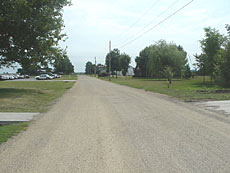|
Council
overrides planning commission, OKs Casey rezoning request
[AUG.
21, 2001] "I
feel for both sides, but I cannot sit here and say ‘no’ to
business in this town," was the way Lincoln Alderman Steve
Fuhrer put it.
|
|
Seven
other aldermen agreed with him, one more than the number required to
override the recommendation of the city’s planning commission,
which Thursday evening voted 6-3 to deny rezoning the property at
314 S. Jefferson St. from residential to commercial so a Casey
General Store could be built on the lot.
Along
with Alderman Fuhrer, Aldermen Benny Huskins, David Armbrust, Pat
Madigan, Verl Prather, George Mitchell, Bill Melton and Joe Stone
voted "yes." The two "no" votes came from Glenn
Shelton and Michael Montcalm.
Fuhrer
said he feels for the people who go out of business because of
competition, but he was elected to make decisions for the entire
town, not just one neighborhood. "When I ran, I wanted to see
Lincoln grow. We’ve lost a lot of business already. We already
have an eyesore by Kroger’s —
purple and gold buildings."

He was
referring to the site where an auto parts store once considered
building. After protests from neighbors, the company withdrew its
offer for the property, and the property owners subsequently painted
the empty buildings in vivid colors.
Before
the vote was taken, several of the aldermen spoke to explain their
stand to the audience that filled the council chambers. Joe Stone
spoke eloquently for the zoning change.
"I’m
greatly disturbed. We have made it increasingly difficult for any
developer to come in here and bring jobs and bring money.
"We
are looking at a piece of real estate that’s a 10-foot-high mound
of dirt. Anything you would put on that piece of ground would look
better than what’s there now."

He
listed the businesses presently along Fifth Street, from the
Postville Courthouse west to Lincoln Parkway, an area Mayor Beth
Davis wants to see become a historic preservation district.
"There’s
a box factory, an abandoned gas station, a couple of other gas
stations, an excavating company, a convenience store, beauty shops,
a bank, a real estate office, empty stores. I say to Casey’s that
if you want to come in here, I’ll vote ‘yes.’"

"There
are legitimate arguments on both sides," Prather said. "I
understand McCumber. I’m sure Graue Pharmacy didn’t like
Walgreen’s coming in, either."
Cliff
McCumber, who with his mother owns the Fifth Street Food Mart two
blocks away from the proposed Casey store, had spoken to protest big
corporations that come in and put small local merchants out of
business.
Verl
Prather, too, noted that the vacant lot has always been an eyesore.
Replying to comments from those who opposed the Casey store next to
the Postville Courthouse, he asked, "How long did that vacant
lot sit there next to a historic site? This is an improvement."
Glenn
Shelton, however, said he was surprised by the aldermen’s
comments, as he thought the council’s priority should be with
businesses already in the city. "Make sure they are going well
and strong," he said. "Casey’s can only hurt established
businesses."

Michael
Montcalm echoed the comments of City Attorney Bill Bates, who
reminded the council that the vote should be regarded as a zoning
issue and not a choice of one business over another.
"It’s
a zoning issue, and we got a recommendation from the zoning
committee. That’s the way I’m looking at this."
[to top of second column in
this article]
|

Before
the vote, a Casey representative and several Lincoln residents
outlined their positions.
Diane
Ahern, Casey representative, said the Casey store would benefit the
city, hiring 12 to 14 people with a $9,000 to $10,000 payroll every
month and paying sales tax on an estimated $1,000,000 yearly.
She
said the company has been looking for an appropriate site in Lincoln
for three years, a desirable site was not easy to find, and if this
site was not approved Casey’s would probably not locate in
Lincoln.
She
also said she had not heard about the proposed historic preservation
district until a week and a half ago. Because the site is in close
proximity to other commercial properties and not a desirable home
site, she said the company believed it had the potential for a
zoning change to commercial use.
Suella
Tucker spoke for residents in the neighborhood. "I don’t want
a Casey’s in my neighborhood. Do you want Casey’s? Do you want
to sit on your deck and look at it? To me it’s that simple. It’s
my neighborhood. Represent us, the people That’s what you’re
here for," she told the council.

She
also submitted a letter to the council signed by herself and seven
others in the area.
Main
Street Lincoln coordinator Wendy Bell, Jan Schumacher of the Looking
for Lincoln steering committee, and Dale Bassi spoke to support the
plan for making the area a historic preservation district.
Bell
said that Main Street Lincoln is not anti-business and that a
historic preservation district does not need to hinder growth. She
read a letter from the director of the Illinois Historic
Preservation Agency which said that "intense commercial use
would be incompatible with the Postville Courthouse" and would
have a negative impact on tourism there.
Schumacher
said tourism is also a way to bring economic growth to Lincoln, and
the Postville Courthouse is a vital part of the tourism program.
Bassi
said that last year the state of Illinois spent more than $400,000
on improvements to the Postville Courthouse. Heritage tourism does
bring people in off the highway, he said, and when the new Lincoln
library opens in Springfield in two or three years, tourism in the
Lincoln area could increase.
"There
is some momentum going on. Casey’s would hinder rather than
enhance the momentum we have gained."

Perry
Harris, who owns two lots across the street, spoke in support of
Casey’s. He objected to the idea that Casey’s doesn’t conform
to the use in the neighborhood, citing a junkyard and an abandoned
gas station.
He
said if the city wants to use the property at 314 S. Jefferson for a
parking lot for visitors to the Postville Courthouse, a suggestion
made by Mayor Davis, they should make an offer and buy it.
"The
problem in Lincoln is too little traffic and too many parking
lots," he said.
Now the Casey corporation
needs to get a variance for a setback requirement from the Zoning
Board of Appeals, which will hear the request Aug. 23 at 6:30 p.m.
If that approval is granted, the company would be free to begin
construction.

[Joan
Crabb]
|
|
Tell
a friend about
Lincoln Daily
News.com |
Our
staff offers more than 25 years of experience in the
automotive industry.
Greyhound
Lube At
the corner of Woodlawn and Business 55 No
Appointments Necessary |
Advertise
your
Garage
Sale in Lincolndailynews.com
--
It's FREE! --
Click
here |
|
|
|

|
|
|
Sewer
line to Campus View homes
must wait for funding
[AUG.
21, 2001] Residents
who live on Campus View Drive may get a chance to hook onto a city
sewer line, but not in the immediate future. The Lincoln City
Council voted 8-2 to put in a sewer line when funding becomes
available.
|
|
Campus
View Drive is a dead-end street that curves behind Lincoln Christian
College. Homes on the street are in the city, but the street belongs
to the college. Twelve homes at the far end of the street presently
have septic systems, which create problems of flooding and sewer
backup for some residents.

At
present the council does not have the money to extend the sewer
lines to the 12 homes, according to Grant Eaton, sewer plant
manager. Putting in a new line and a lift station could cost as much
as $350,000, he said. A possible alternative, using a lift station
belonging to LCC, would cost the city only $150,000 but would
require some or all homeowners to put in ejector pumps, which could
cost the homeowners as much as $6,000.
If the
city uses the college’s lift station, they might also be asked to
maintain it, Eaton said. That would still be much less costly to the
city than any alternate proposal. Eaton said he is pursuing grants
and other funding sources, which are also needed for the mandatory
sewer plant upgrade.
Bill
Melton, chairman of the sewer and drainage committee, said he
believed the homeowners were entitled to have city sewer service,
but pointed out that the council would have the authority to reject
any specific funding allocation for the sewer line in the future.
The vote in favor of extending sewer service was 8-2, with Aldermen
Glenn Shelton and David Armbrust voting "no."
Kevin
Bateman, one of the 12 homeowners, said he was happy with the way
the city voted. "It was a good-faith vote to put sewers there,
to show us homeowners we have not been forgotten," he said.
Bateman
and another homeowner, Mike Robbins, have been attending council
meetings recently to ask for help with the problems they are having
with their septic systems, which are backing up into yards and into
the lower level of Bateman’s home.
In
other business, the council deferred the request by Logan County for
a fiber optic right of way on city property until the next regular
meeting Sept. 4, so the city attorney can redraft the ordinance to
reflect the final changes. The new agreement will run for 10 years
at a nominal cost of $1 a year, and the county will provide the city
with two drops which the city can connect to if it wishes. The
county will maintain the lines.
The
council also agreed to vacate an alley between Adams and Monroe
streets, on property owned by Claude Brinner and being used as a
trailer court. Brinner owns the property on both sides of the alley,
which has not been used as an alley for at least 25 years. No city
utilities, in fact no utilities of any kind, are located in the
alley, according to city engineer Mark Mathon. Brinner has paid all
expenses of the survey.
Fire Chief Robert "Bucky"
Washam announced that the fire department will host an open house on
Monday, Sept. 3. Parents and children are invited to come and tour
the firehouse from 10 a.m. to 2 p.m.
[Joan
Crabb]
|





|
|

|
|
|
Craft
fair, car show, walking tour, souvenirs and class highlight history
[AUG.
18, 2001] At
Wednesday night’s meeting of the Looking for Lincoln Committee,
Thressia Usherwood, executive director of the local tourism bureau,
informed the committee of an 1800s craft fair planned in cooperation
with the Lincoln Art & Balloon Festival.
|
|
The
craft fair is scheduled at the Postville Courthouse from 10 a.m. to
4 p.m. on Sunday, Aug. 26. Entertainment will include Lee Slider as
Professor Phineas Fairhead, practical phrenologist. A Civil
War-period dance demonstration will be from noon to 3 p.m. There
will also be traditional and folk music at various times.
Period
crafts will be demonstrated, such as flax to linen, "Great
Wheel," cabinetmaking, quilting, blacksmithing, basket making,
bobbin lace making and rope making. Admission is free and
refreshments are available. If you need additional information, call
(217) 732-8930.
Saturday,
Aug. 25, the Lincoln Trail Porsche Club Charity Car Show will also
be in progress at the Postville Courthouse, 914 Fifth St. The public
is invited to come and see vintage Porsches from the 356 to current
996.

Jan
Schumacher of the Looking for Lincoln Committee distributed copies
of the folder "Walking on the Path of Abraham Lincoln — A
Walking Tour of Historic Lincoln, Illinois." The folder has
been distributed to many businesses in the county. Copies may be
picked up at Main Street Lincoln, 303 S. Kickapoo St. The folder was
produced by J.R. Glenn and Angie Couch, Lincoln Community High
School students, and Ruth Sloot, instructor. The committee was very
pleased with the work they produced.
[to top of second column in
this article]
|

Linda
Churchill, owner of the Mustard Moon, showed the committee a sample
of glass sun- catchers picturing Postville Courthouse. She ordered
blue, green, amber and other colors. Of the purchase price, 20
percent will go to the Postville Courthouse. The Mustard Moon is at
1314 Fifth St.
Paul
Beaver, historian, reminded the committee members that Lincoln
College offers a semester course "Life of Lincoln and the Civil
War." The class meets from 6:30 to 9 p.m. once a week. Lincoln
College also publishes a Lincoln Newsletter four times a year.
Anyone interested should contact the Lincoln Museum for more
information.
The
next meeting of the Looking for Lincoln Committee is Wednesday,
Sept. 19, at 7 p.m. in the Union Planters Bank conference room.
[Kathleen
McCullough]

|
|

|
|
|
Lincoln
Planning Commission
turns down Casey rezoning
[AUG.
17, 2001] By
a 6-3 vote, the Lincoln Planning Commission turned down a request to
change the zoning on property at 314 S. Jefferson St., across from
the Postville Courthouse, from R-2 (residential) to C-2 (commercial)
use. The zoning change was requested by the property owner, Larry
Riva, so a Casey General Store could be built on the site.
|
|
Voting
in favor of denying the zoning change were commission members Ron
Fox, Scott Cooper, Bob Wood, Leon (Micky) Martin, Dave Klug and
Mayor Beth Davis. Voting not to deny the change were Don Miller,
Mike Miller and commission chair Betty Gehlbach. The Casey
corporation cannot build on that site without the zoning change.
The
commission’s recommendation will now go to the Lincoln City
Council. City Attorney William Bates, who was present at the
meeting, said it would be his guess the council will bring up the
issue at its next meeting on Monday, Aug. 20, even though it is not
on the agenda.
Bates
said the council would probably want to decide if they wished to let
the commission’s decision stand, because the issue is scheduled to
come before the Zoning Board of Appeals on Aug. 22. The Casey
corporation would need a variance in the setback requirements which
only the zoning appeals board can grant. If the council chooses not
to change the commission’s decision, the board of appeals meeting
will be canceled.

Before
taking the vote, the commission heard from about a dozen members of
the crowd that packed the council chamber. Some spoke in favor of
the zoning change and others spoke against it, and not always for
the same reasons.
Diane
Ahern, representative of the Casey company, told the commission that
the company would modify the appearance of the store to be more
compatible with the historic Postville Courthouse. However, the
company would not make a complete change in the store’s look
because its appearance identifies it to customers.
She
said Mayor Beth Davis, who wants a historic corridor along Fifth
Street from the Postville Courthouse to Postville Drive, had
approached her about making the building look like an old-time
country store.
The
Casey store would employ 12 to 14 people and probably pay a sales
tax of about $1,000 a month, Ahern said.
She
said Casey’s has been looking for a site in Lincoln for three
years, and if this one is not approved, the company will probably
not look for another location here.
Perry
Harris, who owns property in the area, spoke in favor of the
rezoning and allowing Casey’s to build.

"Lincoln
seems to be going out of its way to discourage business," he
said. He objected to making Casey’s conform to a historic pattern
because "There’s a mix of stores down here that don’t
conform to anything."
He
also pointed out that the Postville Courthouse is a replica and
therefore is not truly historic.
Cliff
McCumber, who with his mother Judy McCumber owns the 5th Street Food
Mart, a convenience store at 1302 Fifth St., objected to
"corporate USA coming in and taking over our towns.
"Small
businesses care about their communities. If the Little League comes
to me they will get a contribution. If they come to corporate
America they will get all sorts of red tape. I’ll cash people’s
checks. Corporate America won’t."

[to top of second column in
this article]
|

He
said the Casey store would not pay good wages and would not really
bring new business to town but would take business away from
everyone else. "It’s like a pie. The more people you bring
in, the smaller the pieces."
"I
am here in support of our local convenience store, Cliff and his
family," Pete Fredericks of Pete’s Hardware told the
committee. "I think we as citizens of Lincoln should support
and lean on one another. I think we can have economic development,
but I don’t think Casey’s is the answer."
Larry
Goodman of V. Goodman Transfer and Excavating and former owner of
Riva’s lot, spoke to support bringing in the Casey store.
"We’re
trying to get the property back into production. It’s not like we’re
bringing in some sleaze store. This is a quality business. I don’t
see many other people willing to spend $750,000 [to develop the
property]. The jobs may be low-income jobs, but they’re better
than nothing."

Homeowner
Suella Tucker, who lives at 403 S. Madison, said she would like to
see business in Lincoln but did not want Casey’s to go into that
area. "I know it’s selfish, but I don’t want extra traffic,
extra lights and extra music."
Jan
Schumacher, a member of the Looking for Lincoln steering committee,
spoke to support the historic corridor. She passed out brochures for
the Postville Courthouse to commission members "as a reminder
of the important part tourism plays. Tourism brings economic
development. Other small towns are capitalizing on tourism and we
need to do this, too."
She
said Postville is open more days now that volunteers have been
recruited to help staff it. "It had 21 visitors yesterday.
Casey’s is not a complementary building. If you look out Postville
windows and see gas pumps, that’s not historic."
Before
the vote, Bates reminded the commission that they were there simply
to vote on the matter of rezoning, not for any specific business. If
the zoning is changed to C-2, any business permitted under the C-2
designation would be allowed on the site, he said.
"Is
the requested change of zoning in keeping with the comprehensive
plan of this community?" he asked.

Commission
members called for maps to check zoning in the area. Riva’s lot
has R-2 zoning on the north, east and west sides, and C-2 zoning
running west to Lincoln Parkway.
Several
commissioners said they had mixed feelings about the rezoning.
"I’m
really torn on this issue," Mike Miller said before the vote.
"I really think it should be commercial."
"I’m on the other
side of that," Klug said. "I’m for economic development,
and in a sense this tears me up. But I’m voting for my neighbors
and friends."
[Joan
Crabb]
|
|
|
Board
discusses revenue, health coverage and golf course feasibility
[AUG.
17, 2001] Anticipated
decline in assessed valuation of land, clarification of who receives
health coverage and a feasibility study for an airport golf course
drew the most discussion at Thursday night’s work session of the
Logan County Board.
|
|
Finance
Chairman Rod White said next year’s budget will be affected by a
significant drop in the assessed valuation of farmland. "The
farmland in this county will go down by a full 10 percent," he
said. "What I can’t tell you is what is happening to the rest
of the economy, the other 50 percent. We’re fortunate that we have
other sources of revenue," such as the sales tax, to take up
the slack."
A
proposal to extend health insurance coverage "to employees and
those eligible participants employed by entities created by county
resolution" was closely analyzed. The goal is to be sure that
Phil Mahler, new director of the Regional Planning Commission,
receives the same coverage as his predecessor. Mahler has recently
been determined not to be a county employee. White said he feared
excluding employees of bodies such as Job Training Partnership Act,
which were not created by board resolution. "We’re trying to
get somebody in but we may be excluding somebody," he said.
Insurance
Committee Chairman Dale Voyles said he would meet with insurance
carrier Roger Garrett and State’s Attorney Tim Huyett to clarify
wording and inclusiveness.

Airport
Committee Chairman Roger Bock presented a rough draft for an 18-hole
golf course at Logan County Airport, showing hole holes on property
not currently owned by the county. Bock acknowledged that a
nine-hole or executive course is more feasible. "In
reality," he said, "it’s probably going to be an
executive course. This is the biggest thing that would fit [assuming
land purchase]. It sucks up too much land."
Bock
recommended proceeding with a $9,350 economic study to see whether
an airport golf course could be supported by the county. The board
has already set aside $9,000 for such a study. Federal Aviation
Administration approval has not been applied for, but Bock noted
that the FAA has approved other airport golf courses.
He
said the Airport Committee is considering purchasing a credit
card-operated gas pump for use when no attendant is present. Though
the $2.55 price of aviation gas is lower than in surrounding cities,
especially Peoria, sales have dropped as hours have been cut back
[to top of second column in
this article]
|

Logan
County Treasurer Mary Ellen Bruns asked for a tax-sale-in-error fee
of $40 to be assessed for every parcel sold in tax sales. State law
allows a fee up to $60 to cover costs incurred when tax sale
proceeds are refunded after a judge decides an anomaly has occurred.
Bruns said, "It’s advisable to have this so that we’re not
taking money away from the county" for expenses such as postage
and publication. She said larger counties have such a fee, and
smaller counties with few tax sales do not. Logan County had 141 tax
sales in 2000.
Dick
Logan asked anyone seeking the board seat vacated by the resignation
of Phil Mahler to contact him by Monday, Aug. 20.
White
reported that budget hearings begin Aug. 17 at 9 a.m. Requests from
senior citizens groups will be heard at 9:15, with all three who
received funds last year expected to be represented: Central
Illinois Economic Development Council, Healthy Partnership and
Senior Citizens of Logan County.
Roads
and Bridges Chairman Rod White reported that the work on Nicholson
Road will be completed within a week. At the request of residents,
the speed limit in the Oakwood West subdivision off Fifth Street
Road is being reduced to 25 mph.
Board
member Clifford Sullivan spoke in favor of erecting a marker along
Interstate 55 to astronaut Scott Altman, a Lincoln native. He cited
Altman’s many accomplishments, including stunt flying for the
movie "Top Gun."

Mark
Smith, director of economic development, urged those attending the
Lincoln Art & Balloon Festival to visit the hospitality chalet,
which is being used as a promotional tool to showcase Logan County.
"So far the response has been phenomenal," he said.
[Lynn
Spellman]
|
|

|
|
|
Sewer
hookup decision near
for Campus View homes
[AUG.
16, 2001] Lincoln
Christian College has opened the way for the city to provide sewer
hookups for 12 residents living on the far end of Campus View Drive,
but the Lincoln City Council must now decide whether to foot the
$300,000 bill.
|
|
Grant
Eaton, sewer plant manager, told the council at its work session
Aug. 14 that LCC has agreed to give the city an easement for the
sewer line if the city will take over the sewer hookup for the other
homes on Campus View Drive, estimated at about 20.
Although
the homes on Campus View Drive are officially in the city, the
street itself belongs to the college, and the city must have
permission to put in the sewer line. The 12 homes at the far end of
Campus View, which curves around the back of the college property
and then comes to a dead end, have septic systems. Two homeowners,
Kevin Bateman and Mike Robbins, have come to the council to complain
about problems with sewage backup, because their lots are not large
enough for an efficient septic system.

"I
don’t think it’s a bad deal. It’s fair to the city and fair to
the college," Eaton said, in regard to the easement the college
is willing to grant. The other homes on Campus View Drive presently
connect to the LCC waste disposal system.
Eaton
suggested just running a line that would serve the existing homes,
rather than a line that would allow for future growth. He said the
existing line serving the other homes line is shallow and will
require a lift station with a standby power system.
The
question now is whether the council will decide to spend the
$300,000 necessary to provide the hookup for the 12 homes,
especially as City Attorney William B. Bates gave it as his opinion
that the city is not legally required to offer the hookups.
Bateman
said the way he read the ordinance, the city has an obligation to
offer sewer hookups to an existing neighborhood with septic systems
within seven years.
Bates,
however, said the way he interpreted the ordinance is that
homeowners who have septic systems but who have a city sewer line
within reach have an obligation to connect to the city system.

[to top of second column in
this article]
|

"If
that’s the way you read it, I don’t know how you people are
going to vote to spend $300,000 for 12 homes," Bateman said.
"I
know I speak for all 12 homeowners, that not a soul in this town is
going to buy any property out there the way it is," he added.
William
Melton, chairman of the sewage and drainage committee, asked where
funding might come from.
Eaton
answered that the money is not available now but will be when money
comes in for the sewer plant upgrade. He said more and more people
are asking to be connected to the city sewer plant and that the
council needs to consider raising rates to pay for this work and for
the sewer plant upgrade loan from the Illinois Environmental
Protection Agency.
He
also told Bateman and Robbins that even if the council approves the
expenditure, it could take as long as six months before all
paperwork is done and the IEPA approves the project.

Melton
asked that the proposal be put on the agenda for a vote at the next
regular council meeting Aug. 20. "We’ve waited as long as we
can," he said.
In
other business, Street Superintendent Donnie Osborne said he would
like to go back to the original plan for work on the Hamilton Street
garage. Rather than put up a new building, he said he would request
the city to put a new roof on the present structure.
Alderman Glenn Shelton
reported that many residents are concerned that the Illinois
Department of Transportation is planning to wait until next year to
upgrade railroad crossings at Tremont, Pekin and Broadway streets.
He complimented Osborne on following up his request to contact IDOT
to urge them to move more quickly on the upgrades.
[Joan
Crabb]

|
|
Tell
a friend about
Lincoln Daily
News.com |
Our
staff offers more than 25 years of experience in the
automotive industry.
Greyhound
Lube At
the corner of Woodlawn and Business 55 No
Appointments Necessary |
Advertise
your
Garage
Sale in Lincolndailynews.com
--
It's FREE! --
Click
here |
|
|
|
Two
District 27 schools
may get academic warning
[AUG.
16, 2001] Two
District 27 schools, Jefferson and Northwest, will probably be on
the State Board of Education’s Early Academic Warning List this
year, Superintendent Robert Kidd told school board members at their
meeting Aug. 15.
|
|
"This
is a result of not having done as well on the ISAT (Illinois
Standards Assessment Test) as we had hoped over a two-year time
period," Dr. Kidd told the board.
At
Jefferson the test results are for reading, writing and math at the
third-grade level, and at Northwest for reading, writing, and math
at the third- and fifth-grade levels, as well as social science and
science at the fourth-grade level.
"This
is not a shock," Kidd told the board. "We know that test
scores correlate with income level, which we know by the free and
reduced lunch numbers. We know Jefferson has 60 to 70 percent free
and reduced lunch numbers, depending on the time of year, and
Northwest always has 50 percent or greater," he said.
"This
is not an excuse, but it is a challenge," he added.

Official
results and actual tests scores have not yet been sent to District
27, Kidd said. "Until we get the actual scores we won’t know
where the problem really is. Then we will try to come up with
something more effective.
"We
have never made this list before, but being on the warning list may
allow us to get some funds to expand our summer school
program," he added.
The
ISAT tests have replaced the Illinois Goal Assessment Program tests
formerly given to elementary school students. The reading, writing
and math tests are being given for the third year, and the science
and social studies for the second year.
Students
in the district have not done as well on state standardized tests
since the change from IGAP to ISAT, Kidd said. He said it takes a
while for both teachers and students to "catch up" to the
demands of a new test.
He
also noted that the number of special education students at
Jefferson, which is a small school, may have skewed tests results
there as well.
Kidd
also reported on the success of this year’s summer school. Of the
44 students mandated to attend summer school if they wished to be
promoted to the next grade, 36 passed; five failed either for work,
discipline or attendance; and three chose not to come to summer
school.

Of the
79 students recommended, but not mandated, to attend, 62 completed
the summer school program, Kidd said.
The
board also heard the progress of improvements to the ball diamond at
Ralph Gale Field. Kidd credited baseball coach Darrick Reiley and
the crew of volunteers working with him for many of the
improvements.
This
year, dirt was added to the field so it drains better. New bleachers
have arrived and are being assembled, and a new scoreboard, batting
cage and dugouts have been added. New lights will also be installed.
Kidd
said the hollow tree at the corner of Kankakee and Broadway has to
be removed, but he hopes to move some smaller trees from the Central
School grounds to Ralph Gale Field to provide shade for spectators.

[to top of second column in
this article]
|

Board
president Bruce Carmitchell also reported on the agreement with the
Illinois Historic Preservation Agency. The IHPA wants to be sure the
school district properly recognizes the historic significance of the
buildings that will be demolished. The district has agreed to
document the old buildings with photographs and videotape and to
include in its curriculum information about the structures that were
formerly there.
Architect
Dave Leonatti and construction manager Bill Ahal reported that the
design development for the new Central School is completed and the
development of final documents needed before construction begins is
10 percent completed.
Construction
drawings are scheduled to be finished by Oct. 20 so bids can be let.
The project will be assembled in "bid packages," with
foundation work being the first to be let.

Both
Leonatti and Ahal said they hoped to see ground broken before the
end of the year. The building program is behind schedule because of
the extra time needed to bring the cost of the two new schools,
Central and a new junior high school, in line with the funds
available. Total square footage of the new Central School will be
47,375, slightly smaller than the original plans, and the cost
estimates are in the range of $119 to $125 per square foot.
Ahal
reported that the sewer line on the Central School grounds will have
to be moved, as right now it runs under the site of the new
building. However, he said that was "not a major problem."
Leonatti
said that as work progresses it may be necessary to call special
meetings of the board or the construction committee to approve plans
as they are completed and expedite the bidding process. Board
president Bruce Carmitchell said the board would be ready to act
whenever it was necessary.

Both
Leonatti and Ahal said the timing is right for the district to
realize some cost savings. Contractors are finishing jobs on
existing schools in time to meet fall school schedules and are
looking for new projects, they said.
"The
later in the year, the better off we’ll be as far as the
market," Ahal said. "This has been true in all my 24 years
of experience. I am seeing much more availability of
materials."
Leonatti said he has had a
larger than usual number of contractors bidding on projects right
now.
[Joan
Crabb]
|
|

|
|
|
City
historic preservation
ordinance put on hold
[AUG.
15, 2001] If
the city of Lincoln is going to have a historic preservation
ordinance, it won’t be soon.
|
|
"This
is not going to be a quick procedure," said Pat Madigan, vice
chairman of the city council’s ordinance committee, reporting on
the proposed ordinance which council members received a week ago.
"There are a lot of things to be ironed out before we are done.
"I
don’t think we can resolve this in a couple of meetings and push
it through," he added.
Madigan’s
assessment of the 13-page document, which was shared by other
members of the committee present, sounded like good news to a group
of citizens who came to the committee meeting, most of them property
owners on or near the Fifth Street corridor which Mayor Beth Davis
has said she would like to see as a historic preservation district.
Larry
Goodman, who owns V. Goodman Transfer, a trucking and excavating
company at 1202 Fifth St., said he was relieved to hear the council’s
consensus.
"I
have a little more confidence since I’ve heard you speak that this
will not be railroaded through," he told the ordinance
committee. He said he had been wondering if he would be able to pass
on his property to his children, so they could run the family
business as the fourth generation.
Also
he questioned whether there was anything historical in the proposed
Fifth Street corridor.
"We’ve
been on that corner since 1926. If there was any history there, I
think I’d have been aware of it."
Mayor
Davis assured him that the council had no intention of
"railroading" the ordinance through. She said she saw it
as a way to help property owners get grants to restore and maintain
historic structures. She said she had also hoped to have several
other historic sites on Fifth Street, a facade of the old Deskins
Tavern where Abraham Lincoln stayed and some replicas of early homes
in the nearby park.
Perry
Harris, also a Fifth Street property owner, said it appeared that
the ordinance was created to stop the Casey General Store from
building a facility on Fifth Street.
"The
speed this appeared before the council is troubling. It seems like
the ordinance was created to stop Casey’s," he said.
The
Casey corporation has been negotiating with Larry Riva, who owns a
Fifth Street lot just west of the Postville Courthouse, to buy Riva’s
property to put up a convenience store. A representative of Casey’s
was present at Tuesday night’s meeting but did not speak.
"Why
not table the ordinance until the Casey’s issue has been
settled?" Harris asked.
David
Morrow told the committee that the proposed ordinance for Lincoln
was more sweeping and more restrictive than the requirements for
getting a structure on the National Historic Register and should not
be passed in its present form.
"A
lot of businesses on Fifth Street are worried about it. They couldn’t
even change colors on their buildings under this ordinance. The
majority of people have no idea what this ordinance does.
"I
can’t emphasize how much trouble this [type of ordinance] does in
other communities. It enslaves the property of the citizens of
Lincoln."
Under
the proposed ordinance, if a property has a historic designation,
changes to the outside or demolition of the property would have to
have the approval of the historic preservation committee.
City
Attorney William B. Bates pointed out that the ordinance had not
been created by the council but by Main Street Lincoln. Wendy Bell,
Main Street Lincoln coordinator, said the organization realized that
the ordinance was just a "starting point."
[to top of second column in
this article]
|
Outlining
the problems he found with the proposed ordinance, Madigan cited the
"power and autonomy" granted to the 11 members of the
historic preservation committee, who would be appointed by the
mayor.
"How
much power do we want to give 11 people not even elected by the
community? We may end up with a specialized committee that will have
an over-zealous view."
He
also objected to the power given the council. As the document is
written, a simple majority would be able to ratify a decision made
by the historic preservation committee. Madigan said he believed any
such decision made by the council should be either a two-thirds
majority or a unanimous vote.
David
Armbrust disagreed with the provision that the committee would be
able to nominate and vote on making a structure a historic landmark
without the consent of the owner.
"It
is the owner who should be asking [for the historic designation],
not just someone who drives by," he said.
"If
the owner doesn’t want to have the historic landmark designation,
he shouldn’t be forced. He should be able to modify his home as he
wants," Madigan agreed.
Armbrust
and Madigan also agreed that they did not like the provision that
one-third of the people in an area could nominate it as a historic
district. "I’d hate to think one-third of the people in a
given area could dictate to the others," Armbrust said.
Both
also found the appeal process unsatisfactory. As it is presently
written, a property owner can appeal a ruling on his property only
to the commission, the same body that made the ruling in the first
place.
"There
is very little recourse for those that fall within the
district," Madigan said.
Another
objection Madigan cited was the "what if" criterion for
historic designation. He cited one example from the proposed
ordinance: "An area that has yielded or may be likely to yield,
information important in history or prehistory."
"If
we are going to designate a landmark, we need hard evidence. We can’t
say ‘what if’ or ‘This is going to be an important site
someday.’"
In
spite of his objections, however, Madigan described the document as
a "framework" that could be formulated to fit the city of
Lincoln.
"Each
page will have to be addressed," he said. "We need a
better system of checks and balances. There are a lot of holes in
this ordinance that we are not going to be able to patch up on a
short-term basis."
Madigan, who took over for
ordinance committee chairman Michael Montcalm, who is on vacation,
did not schedule a future meeting for the committee. In the
meantime, Riva will appear before the planning commission on Aug. 16
to ask for a rezoning of his lot from R-2 (residential) to C-4
(commercial), so that the Casey corporation could put up the
convenience store. If the planning commission agrees to the zoning
change, he will appear before the zoning board of appeals on Aug.
22. After that, plans for the Casey General Store will have to be
approved by the full council.
[Joan
Crabb]
|
|
|
Real
estate taxes come due
The
Logan County treasurer’s office announces the following dates:
|
|
Sept.
5 — Final day to pay the second installment of real estate taxes
without a penalty.
Sept.
6 — A penalty of 1½ percent will be charged on any unpaid second
installment of taxes. A penalty of 4½ percent will be charged on
any unpaid first installment of taxes.
Sept.
20 — Warning letters for any unpaid taxes will be mailed.
Oct.
4 — Certified letters will be mailed.
Oct.
15 — Listings of any unpaid tax will be published.
The
Logan County treasurer’s office has been notified that E-Pay, the
credit card option established by the state treasurer’s office for
public fund treasurers, will not be available until Jan. 1, 2002.
The local office had hoped this option would be available in time
for the second installment; however, due to legislative action, the
effective date was changed. The Logan County treasurer’s office
has, however, installed a debit card scanner for all debit cards and
ATM cards.
[to top of second column in
this article]
|
Effective
Aug. 17, the county treasurer’s office will be able to accept the
Discover card. The Discover card company has a program for county
treasurers that has been in place in larger counties for some time.
County treasurers collect a user free from taxpayers who use the
Discover card to pay their taxes, thereby creating no additional
expense for the county.
As
in the past, the county treasurer’s office is asking that banks do
not collect any real estate tax after their close of business on
Sept. 5. The banks will again collect taxes for the 2002 fiscal year
tax cycle as they have every year.
Taxpayers are reminded of the
drop box in the city parking lot on North Kickapoo Street.
Taxpayers
having any questions are asked to call 732-3761 between 8:30 a.m.
and 4:30 p.m.
[News
release]
|
|
|
Logan
County Board sets budget review
The
Logan County Board started its FY 2002 budget review hearings Friday
morning, Aug. 17. Sessions will continue
Wednesday, Aug. 22, from 8 a.m. to noon; Thursday, Aug. 23, from 1
to 4 p.m.; and Friday, Aug. 24, possibly beginning at 8:30 a.m.
When
all hearings are completed, the information will be assembled for
analysis. After that the auditors will schedule and make a
presentation to the full board.
All
meetings are in the third-floor jury room at the Logan County
Courthouse and are open to the public.
[News
release]
|
|
|
Back
to top
|
News
| Sports
| Business
| Rural
Review | Teaching
& Learning | Home
and Family | Tourism
| Obituaries
Community | Perspectives | Law
& Courts | Leisure Time | Spiritual
Life | Health
& Fitness | Letters
to the Editor
|
|